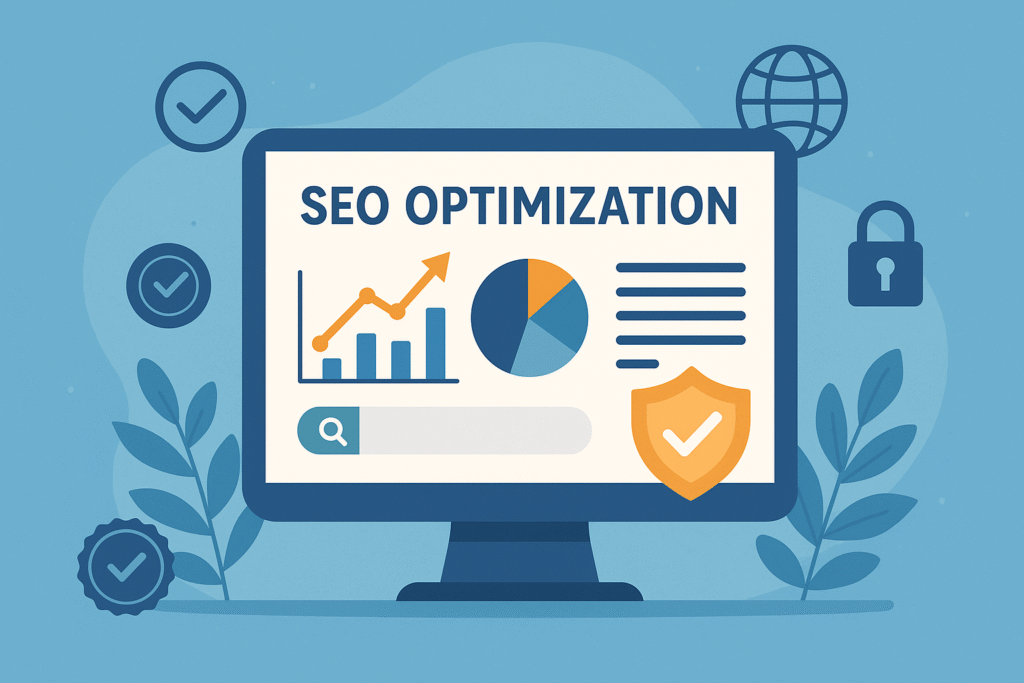
Introduction
In today’s digital world, customers often make snap judgments about your brand based on what they find online. In that narrowed window of time, trust becomes your most valuable currency. Smart SEO optimization does more than boost rankings—it helps your brand convey reliability, credibility, and long‑term value. In this article, we’ll explore how SEO shapes trust and credibility online, and how you can leverage it for your brand.
1. Why Trust and Credibility Matter in the Digital Space
Trust and credibility are the foundations of meaningful customer relationships. When a visitor arrives on your site, they ask subconsciously: “Can I rely on this brand? Is this site safe, professional, relevant?”
In those moments, trust can be won or lost through various signals—some subtle, yet powerful. When your SEO efforts align with these trust signals, you gain a meaningful edge.
2. How SEO Optimization Builds Visibility — and Why That Boosts Credibility
A key benefit of SEO optimization is enhanced visibility. When your brand appears prominently in search results, it sends multiple signals:
- That your site is relevant to the user’s query.
- That search engines (which users trust) consider your site authoritative enough to rank.
- Familiarity breeds trust: repeated exposure to your brand across search contexts builds recognition and comfort.
This alignment of visibility and user perception is a core mechanism by which SEO helps build credibility.
3. Key SEO Components That Drive Trust & Credibility
3.1 Quality Content Aligned with User Intent
Effective SEO optimization means delivering content that genuinely answers the user’s question—not just containing keywords. By aligning content with intent, you demonstrate that your brand understands and values your audience. This builds expertise and trust.
3.2 Technical SEO & Positive User Experience
SEO isn’t just about keywords: site speed, mobile responsiveness, secure protocols (HTTPS), and logical structure matter. These are trust signals in themselves—if a site loads slowly or feels unreliable, users may question credibility regardless of content quality.
3.3 Authority Signals: Backlinks, Brand Mentions & E‑A‑T
Search engines evaluate signals like backlinks, author credentials, brand reputation and content originality. The framework of E‑E‑A‑T (Experience, Expertise, Authoritativeness, Trustworthiness) explicitly links SEO optimization with credibility.
3.4 Consistent Online Presence & Reputation Management
Finally, SEO optimization includes managing how your brand appears across the web: consistent branding, accurate listings, reviews, social signals. All these support the perception of trust and reliability.
4. Practical Steps to Use SEO Optimization to Build Trust
- Audit your current state: review site speed, mobile usability, content relevance, backlink profile.
- Craft content around user intent: use your focus keyphrase “SEO Optimization” naturally in titles, headings and body where it makes sense.
- Strengthen technical foundation: page speed, structured data, HTTPS, schema markup.
- Build authority backlinks and mentions: guest posts, partnerships, authentic brand references.
- Ensure consistency in brand representation: same brand name, logos, messaging across search results, listings, citations.
- Monitor trust‑signals and user behaviour: bounce rate, return users, dwell time, brand searches—not just rankings.
5. Measuring Impact & Avoiding Common Pitfalls
When focusing on trust and credibility via SEO optimization, keep your eye on:
- Organic new visitor growth + recurring visitor ratio.
- Engagement metrics: time on page, pages per visit, return visits.
- Keyword positioning for intent‑based queries (not just broad keywords).
Common pitfalls include: - Prioritizing keywords alone (without intent or experience).
- Neglecting UX or mobile performance.
- Chasing backlink quantity over relevance and quality (which can damage credibility).
- Inconsistent branding and messaging across digital touchpoints.
Conclusion
SEO optimization isn’t just about ranking higher—it’s about building trust. When you optimize your site for relevance, authority, performance and consistent brand signals, you cultivate credibility in the eyes of both users and search engines. If you’re serious about building lasting brand presence, focus not just on visibility—but on the quality of that visibility.
Take action: assess your SEO posture today, align your brand for trust, and build momentum for the long term.
FAQs
Q1. What is the link between SEO optimization and brand trust?
A1. SEO optimization enhances a site’s relevance, authority and experience which contribute to user perceptions of reliability—thus boosting brand trust.
Q2. How quickly can improvements in SEO optimization impact credibility?
A2. Some visible changes (like site speed) can help immediately; deeper trust and authority gains typically build over months as content, backlinks and brand presence mature.
Q3. Can SEO optimization compensate for other issues like poor product or service quality?
A3. Not fully—SEO optimization supports trust and credibility, but it cannot mask fundamental issues like poor offerings. Both must align.
Q4. For credibility, is backlink quantity or quality more important?
A4. Quality wins: backlinks from reputable, relevant sources matter far more than volume alone.
Q5. What’s the first SEO optimization step a brand focused on trust should take?
A5. Begin with technical health and user experience: ensure your site loads quickly, is secure (HTTPS), mobile‑friendly, and presents clear, reliable content.

